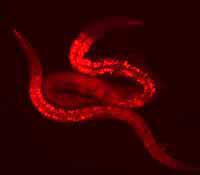Opposing fat metabolism pathways triggered by a single gene

Regulation of b-oxidation gene expression by nhr-49. Photo: Keith Yamamoto et al.
Regulating metabolism of fat is an important challenge for any animal, from nematodes to humans. Central players in the regulatory network are the nuclear hormone receptors (NHRs), which are transcription factors that turn on or off a set of target genes when bound by specific lipid molecules. In the premier open-access journal PLoS Biology, Keith Yamamoto and colleagues show that the nuclear hormone receptor nhr-49 controls two different aspects of fat metabolism, which interact to form a feedback system controlling the consumption and composition of fats in the nematode.
Using RNAi to suppress gene expression, the researchers discovered that when nhr-49 was absent, the lifespan of the nematode was reduced by more than 50%, and the animal displayed numerous gross abnormalities in the gut and gonad. This was accompanied by unusually high fat content in the larvae. They further showed that deletion of nhr-49 changed expression of 13 genes related to fat and glucose metabolism, with the most dramatic effects occurring within two metabolic pathways: mitochondrial lipid oxidation and fatty acid desaturation.
Following up on these changes in gene expression, Yamamoto and colleagues show that in its normal actions, nhr-49 sets in motion two opposing pathways: it increases expression of a gene acs-2, which leads to reduction of fat content, and it increases expression of another gene fat-7, which, by reducing acs-2, increases fat content. In its function, nhr-49 resembles a mammalian NHR, called peroxisome proliferator-activated receptors (PPARs). Further investigation of this link may lead to better understanding of the functions of PPARs and provide opportunities for altering their function for treatment of fat metabolism disorders such as diabetes and obesity.
Media Contact
All latest news from the category: Life Sciences and Chemistry
Articles and reports from the Life Sciences and chemistry area deal with applied and basic research into modern biology, chemistry and human medicine.
Valuable information can be found on a range of life sciences fields including bacteriology, biochemistry, bionics, bioinformatics, biophysics, biotechnology, genetics, geobotany, human biology, marine biology, microbiology, molecular biology, cellular biology, zoology, bioinorganic chemistry, microchemistry and environmental chemistry.
Newest articles

A universal framework for spatial biology
SpatialData is a freely accessible tool to unify and integrate data from different omics technologies accounting for spatial information, which can provide holistic insights into health and disease. Biological processes…

How complex biological processes arise
A $20 million grant from the U.S. National Science Foundation (NSF) will support the establishment and operation of the National Synthesis Center for Emergence in the Molecular and Cellular Sciences (NCEMS) at…

Airborne single-photon lidar system achieves high-resolution 3D imaging
Compact, low-power system opens doors for photon-efficient drone and satellite-based environmental monitoring and mapping. Researchers have developed a compact and lightweight single-photon airborne lidar system that can acquire high-resolution 3D…





















